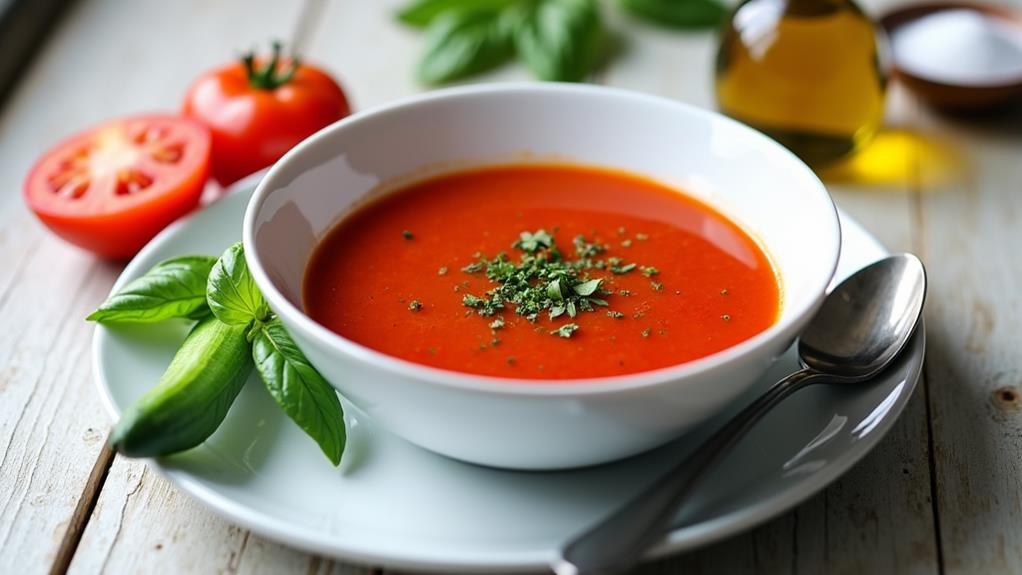You've likely encountered gazpacho before, but have you experienced the vibrant twist that fresh herbs can bring to this classic Spanish soup? While traditional recipes rely on ripe tomatoes and cucumbers for their refreshing base, the addition of aromatic herbs like basil, cilantro, or parsley can elevate this dish to new heights. As you consider the endless possibilities for customizing your gazpacho, you'll find that experimenting with different herb combinations not only enhances the flavor profile but also adds a visually appealing element to your summer table. But what's the secret to perfectly balancing these herbal notes?
Key Takeaways
- Fresh herbs like basil, parsley, or cilantro enhance gazpacho's flavor profile and add depth to the classic recipe.
- Experiment with different herb combinations to create unique variations of gazpacho that suit your taste preferences.
- Add herbs during the blending process or as a garnish before serving for varied texture and visual appeal.
- Chilling gazpacho with fresh herbs allows flavors to meld, resulting in a more complex and refreshing soup.
- Use high-quality, ripe tomatoes and fresh herbs to ensure the best flavor in your gazpacho.
History
Tracing the origins of gazpacho reveals a rich culinary history. This cold soup's roots stretch back to ancient times, with its earliest forms originating in the Andalusia region of southern Spain.
You'll find that gazpacho's creation was born out of necessity, as field workers needed a quick, refreshing meal to combat the scorching heat.
Initially, gazpacho was a simple blend of stale bread, olive oil, garlic, and vinegar, pounded together in a mortar. It wasn't until the discovery of the New World that tomatoes were introduced to the recipe, transforming it into the vibrant red soup we know today.
As gazpacho evolved, it became a staple in Spanish cuisine, with countless regional variations emerging.
In the 20th century, gazpacho gained international recognition, spreading beyond Spain's borders and becoming a popular summer dish worldwide.
Chefs and home cooks alike have put their own spin on the recipe, incorporating various ingredients and techniques.
Today, you'll find gazpacho served in everything from fine dining establishments to casual cafes, a testament to its enduring appeal and versatility.
Recipe
Gazpacho is a refreshing Spanish cold soup that's perfect for hot summer days. This simplified version with fresh herbs captures the essence of the traditional recipe while keeping the ingredient list short and accessible.
This quick and easy gazpacho recipe showcases the vibrant flavors of ripe tomatoes and cucumbers, enhanced by the aromatic presence of fresh herbs. The result is a light, tangy, and incredibly refreshing soup that can be prepared in minutes and served chilled for maximum enjoyment.
- 4 large ripe tomatoes, roughly chopped (about 4 cups / 600g)
- 1 medium cucumber, peeled and roughly chopped (about 1 cup / 150g)
- 2 tablespoons red wine vinegar
- 1/4 cup (60ml) extra-virgin olive oil
- 1/4 cup (15g) mixed fresh herbs (such as basil, parsley, and mint)
- Salt and pepper to taste
To prepare the gazpacho, simply combine all ingredients in a blender or food processor. Blend until smooth, or leave it slightly chunky if you prefer more texture.
Taste and adjust the seasoning with salt and pepper as needed. Transfer the soup to a container and refrigerate for at least an hour before serving to allow the flavors to meld and the soup to chill thoroughly.
For the best flavor, use the ripest tomatoes you can find. If your tomatoes aren't at peak ripeness, you can add a pinch of sugar to balance the acidity. Don't be afraid to experiment with different herb combinations to suit your taste.
For a smoother consistency, you can strain the soup through a fine-mesh sieve before chilling. Serve the gazpacho in chilled bowls or glasses, and garnish with a drizzle of olive oil and a few herb leaves for an elegant presentation.
Cooking Steps
To prepare this refreshing gazpacho, you'll start by roughly chopping the tomatoes and cucumber.
Next, you'll combine all the ingredients in a blender or food processor, blending until you achieve your desired consistency, whether smooth or slightly chunky.
Step 1. Chop Tomatoes and Cucumber
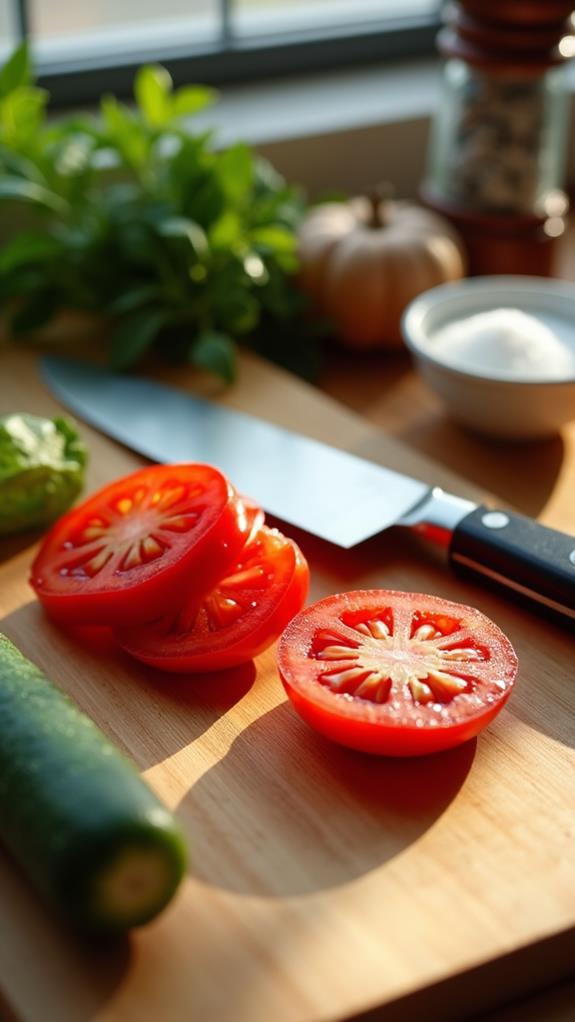
Let's start by preparing the main ingredients for our gazpacho. You'll need four large, ripe tomatoes and one medium cucumber.
Begin by washing the tomatoes thoroughly under cool running water, removing any dirt or debris. Next, cut out the stem and any blemishes, then roughly chop the tomatoes into chunks about 1-inch in size. Don't worry about being too precise; they'll be blended later.
For the cucumber, peel off the skin using a vegetable peeler or paring knife. If you prefer, you can leave some strips of skin on for added texture and color. Slice the cucumber in half lengthwise and use a spoon to scoop out the seeds. This step isn't strictly necessary, but it can help reduce excess liquid in your gazpacho.
Once deseeded, roughly chop the cucumber into pieces similar in size to the tomatoes.
As you're chopping, you'll notice the vibrant colors and fresh aromas of these vegetables. This visual and olfactory experience is part of what makes gazpacho so appealing.
Step 2. Combine Ingredients in Blender
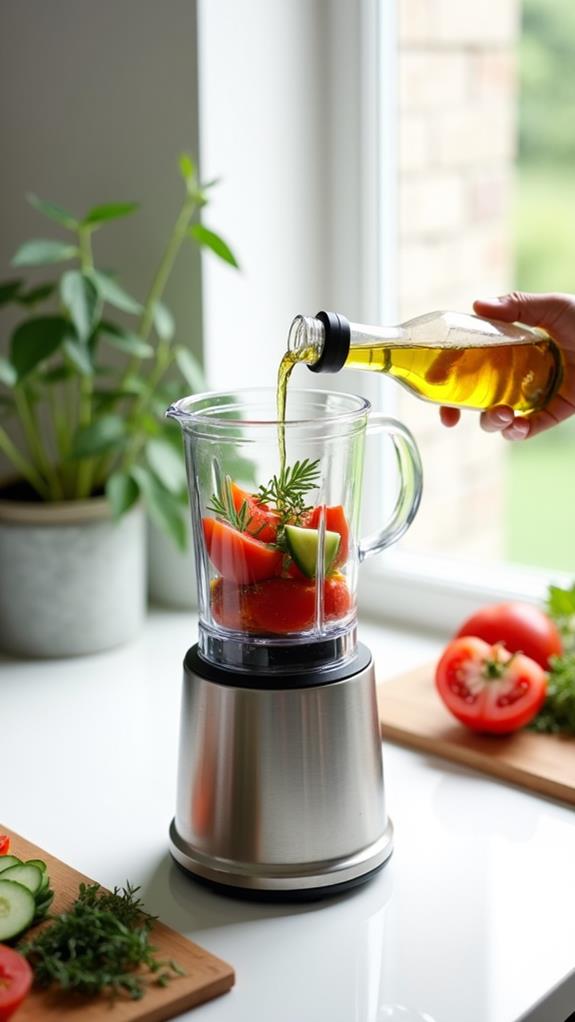
With your chopped vegetables ready, it's time to combine all the ingredients in the blender. Start by adding the roughly chopped tomatoes and cucumber to the blender jar. Next, pour in the red wine vinegar and extra-virgin olive oil. These liquid ingredients will help create a smooth consistency and enhance the flavor profile of your gazpacho.
Now, add the fresh herbs you've chosen – basil, parsley, and mint are excellent options that'll bring a vibrant, aromatic quality to your soup.
Before blending, ensure the lid is securely fastened to prevent any messy accidents. Begin blending on a low speed, gradually increasing to medium as the ingredients start to break down. If you prefer a smoother consistency, blend for a longer period. For a chunkier texture, pulse the mixture in short bursts.
You'll want to blend until the gazpacho reaches your desired consistency, typically about 30-60 seconds. Once blended, taste the soup and adjust the seasoning with salt and pepper as needed. If you find the gazpacho too thick, you can add a little cold water or tomato juice to thin it out.
Step 3. Blend Until Desired Consistency
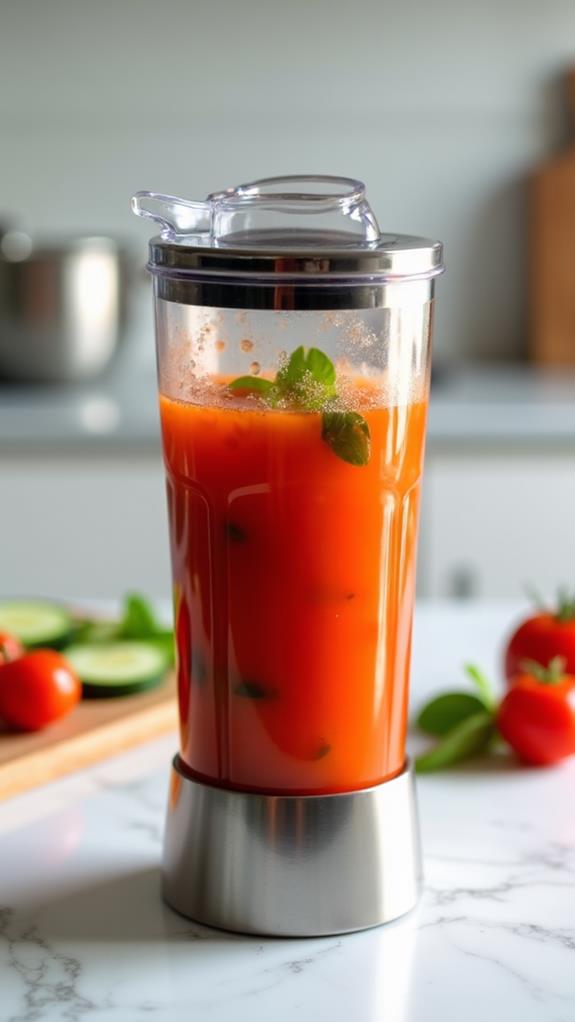
Blending your gazpacho to the perfect consistency is a crucial step in creating this refreshing soup. Start by pulsing the ingredients a few times to break them down, then switch to a continuous blend.
You'll want to aim for a smooth texture, but don't overdo it, as you risk incorporating too much air and altering the soup's flavor.
Keep an eye on the mixture as it blends, stopping occasionally to scrape down the sides of the blender with a spatula. This ensures all ingredients are evenly incorporated.
If you prefer a chunkier gazpacho, blend for a shorter time or reserve some of the chopped vegetables to stir in later. For an ultra-smooth consistency, you can strain the soup through a fine-mesh sieve after blending.
Step 4. Adjust Seasoning to Taste
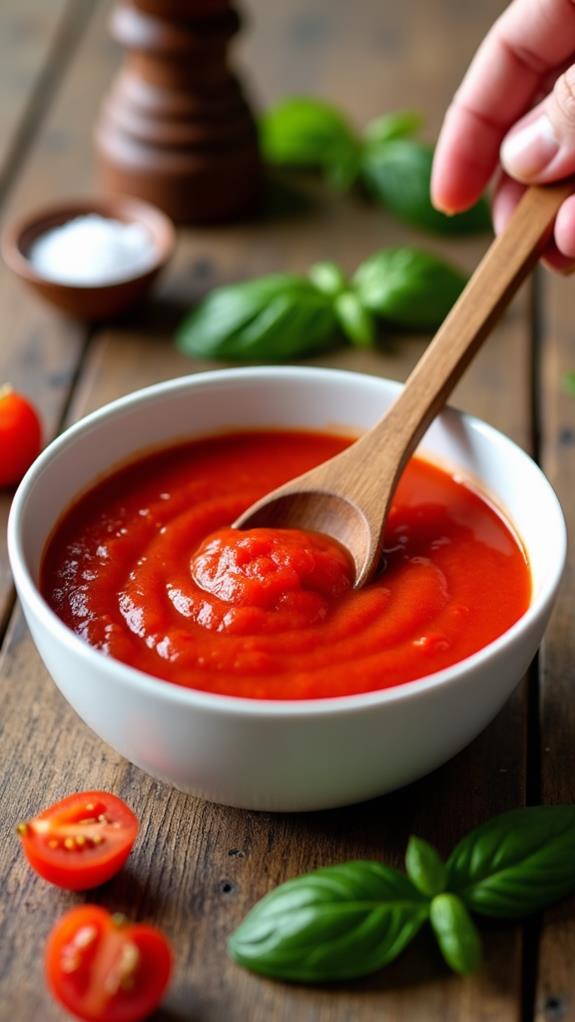
Seasoning adjustment is a crucial step in perfecting your gazpacho. After blending the ingredients, take a moment to taste your soup and assess its flavor profile. You'll want to strike a balance between the acidity of the tomatoes, the freshness of the cucumber, and the aromatic notes of the herbs.
Start by adding a pinch of salt and a few grinds of black pepper, then taste again. If the soup tastes flat, gradually add more salt until the flavors pop. Should you find the gazpacho too acidic, consider adding a small amount of sugar to balance it out. On the other hand, if it lacks brightness, a splash more red wine vinegar can help.
Don't forget to taste after each addition, as small adjustments can make a big difference. Remember, the flavors will continue to develop as the soup chills, so it's okay to slightly under-season at this stage. Trust your palate and adjust until you're satisfied with the taste.
Once you've achieved the perfect balance, refrigerate your gazpacho to allow the flavors to meld and intensify.
Step 5. Chill Before Serving

Chilling is a crucial step in preparing the perfect gazpacho. After blending your ingredients, you'll want to refrigerate the soup for at least an hour before serving. This cooling period allows the flavors to meld and intensify, resulting in a more harmonious and refreshing dish.
During this time, the gazpacho's texture will also improve, becoming smoother and more cohesive. To expedite the chilling process, you can place the blended soup in a metal bowl and set it in an ice bath. Stir occasionally to ensure even cooling.
Alternatively, if you're not in a rush, simply cover the bowl with plastic wrap and let it chill in the refrigerator for several hours or overnight. This extended cooling time often yields the best results, as the flavors have more opportunity to develop fully.
Before serving, give the gazpacho a quick stir to redistribute any ingredients that may have settled. Taste and adjust the seasoning if necessary, as cold temperatures can dull flavors slightly.
Pour the chilled soup into pre-cooled bowls or glasses to maintain its refreshing temperature throughout the meal.
Final Thoughts
This gazpacho's simplicity is its greatest strength. You'll find that this quick and easy recipe allows you to enjoy the authentic flavors of Spain without spending hours in the kitchen. By using fresh, high-quality ingredients, you're ensuring that each spoonful bursts with vibrant taste and nourishment.
Don't hesitate to adjust the proportions to suit your preferences, whether you prefer a thicker consistency or a more pronounced herb flavor.
Remember that gazpacho is incredibly versatile. You can serve it as a refreshing appetizer, a light lunch, or even as a palate cleanser between courses. It's also an excellent way to incorporate more raw vegetables into your diet, providing a healthy boost of vitamins and antioxidants.
As you become more comfortable with the basic recipe, consider experimenting with additional ingredients like bell peppers, garlic, or even watermelon for unique twists.
Ultimately, this gazpacho recipe offers a perfect balance of tradition and convenience, allowing you to create a delicious, restaurant-quality soup in the comfort of your own home.

